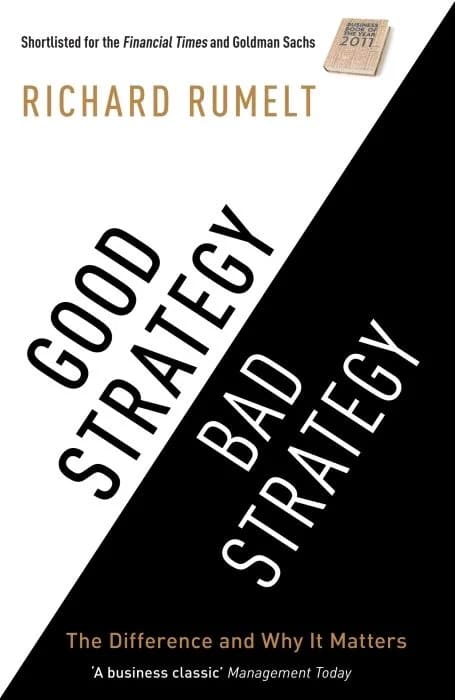Good Strategy Bad Strategy: The Difference and Why It Matters
Richard P. Rumelt

Clears out the mumbo jumbo and muddled thinking underlying too many strategies and provides a clear way to create and implement a powerful action-oriented strategy for the real world
Developing and implementing a strategy is the central task of a leader, whether the CEO at a Fortune 100 company, an entrepreneur, a church pastor, the head of a school, or a government official. Richard Rumelt shows that there has been a growing and unfortunate tendency to equate Mom-and-apple-pie values, fluffy packages of buzzwords, motivational slogans, and financial goals with “strategy.” He debunks these elements of “bad strategy” and awakens an understanding of the power of a “good strategy.”
A good strategy is a specific and coherent response to—and approach for overcoming—the obstacles to progress. A good strategy works by harnessing and applying power where it will have the greatest effect in challenges as varied as putting a man on the moon, fighting a war, launching a new product, responding to changing market dynamics, starting a charter school, or setting up a government program. Rumelt’s
nine sources of power—ranging from using leverage to effectively focusing on growth—are eye-opening yet pragmatic tools that can be put to work on Monday morning.
Surprisingly, a good strategy is often unexpected because most organizations don’t have one. Instead, they have “visions,” mistake financial goals for strategy,
and pursue a “dog’s dinner” of conflicting policies and actions.
Key Summary
“Good Strategy Bad Strategy” argues that most strategies are vague, confused, and often lacking focus. The author, Richard Rumelt, suggests that a good strategy is one that has a clear understanding of a company’s strengths, weaknesses, opportunities and threats and that it has a “kernel” or central idea that guides its actions. He defines a good strategy as one that creates a unique and valuable position in the marketplace, and is actionable and executable.
Takeaways
1. A good strategy must have a clear understanding of a company’s strengths, weaknesses, opportunities, and threats.
2. A good strategy must have a “”kernel”” or central idea that guides its actions.
3. A good strategy must create a unique and valuable position in the marketplace.
4. A good strategy must be actionable and executable.
5. Good strategy requires discipline and focus.
6. Strategies must be constantly evaluated and adapted as necessary.
7. Good strategy should leverage a company’s strengths and overcome its weaknesses.
8. Good strategy should take advantage of opportunities and address threats.
9. Strategy should be integrated throughout an organization.
10. Good strategy requires leadership, collaboration, and communication to be executed effectively.